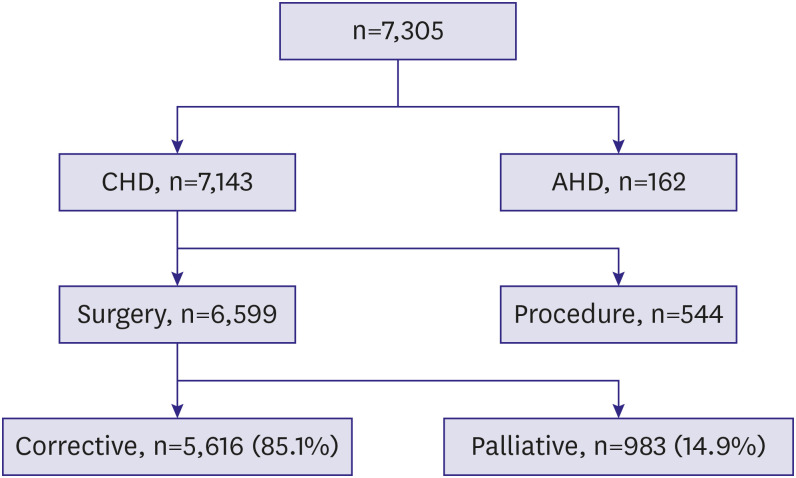Korean Circ J.
2020 Aug;50(8):677-690. yhpark@yuhs.ac.
Recent Surgical Outcomes ofCongenital Heart Disease according toKorea Heart Foundation Data
- Affiliations
-
- 1Department of Thoracic and Cardiovascular Surgery, Korea University Ansan Hospital, Korea University College of Medicine, Ansan, Korea
- 2Division of Cardiovascular Surgery, Congenital Heart Disease Center, Severance Cardiovascular Hospital, Department of Thoracic and Cardiovascular Surgery, Yonsei University College of Medicine, Seoul, Korea
- 3The Korea Heart Foundation, Seoul, Korea
- KMID: 2505121
- DOI: http://doi.org/yhpark@yuhs.ac
Abstract
- Background and Objectives
This study presents an update of the surgical outcomes ofcongenital heart disease (CHD) according to Korea Heart Foundation (KHF) data.
Methods
We investigated the data of the 7,305 patients who were economically supportedby KHF in 2000–2014. Of them, we analyzed surgical outcomes of the 6,599 patients whounderwent CHD surgery.
Results
The median patient age was 1.9 years (range, 0–71.5 years). Of the 6,599 patients,5,616 (85.1%) underwent biventricular repair and 983 (14.9%) underwent palliativeprocedures. The mean Basic Aristotle Score was 6.6±2.2. A complex procedure (definedas Basic Aristotle Score above 6) was performed in 3,368 patients (51.0%). The earlymortality rate was 3.8%, while the late mortality rate was 1.8%. Previous reports of the KHF(1984–1999) showed that the early surgical and late mortality rates were 8.6%, and 5.3%,respectively. There were 491 neonates (7.4%); among them, the early mortality rate was 12.2%and late mortality rate was 3.7%. There were 2,617 infants (40.0%); among them, the earlymortality rate was 6.0% and the late mortality rate was 2.3%. A total of 591 patients from 30countries were helped by the KHF.
Conclusions
More neonatal surgeries (491 vs. 74 patients) were performed than those inthe past (1984–1999). The surgical outcomes were much better than before. Our surgicaloutcomes revealed that the Republic of Korea has been transformed from a country receivinghelp to a country that helps other low socioeconomic status countries.
Figure
Reference
-
1. Baptist Health. South Korean man returns to Jacksonville 21 years after local heart surgeons saved his life: reunion with doctors, philanthropists, will take place on March 28 [Internet]. Jacksonville (FL): Baptist Health;2008. cited 2020 Feb 7. Available from https://www.baptistjax.com/about-us/newsroom/news-releases/south-korean-man-returns-to-jacksonville-21-years-after-local-heart-surgeons-saved-his-life.2. Catholic Times. Busan Children's Heart Disease Consultation Center: free surgery for 50 patients [Internet]. Daegu: Catholic Times;1983. cited 2020 Feb 7. Available from https://www.catholictimes.org/article/article_view.php?aid=219650¶ms=page%3D3709%26acid%3D1.3. The New York Times. Foreign children given gift of life [Internet]. New York (NY): The New York Times Company;1983. cited 2020 Feb 7. Available from https://www.nytimes.com/1983/11/15/nyregion/foreign-children-given-gift-of-life.html.4. Rotary International District 3650. About “Gift of Life Korea” [Internet]. Seoul: Rotary International District 3650;2019. cited 2020 Feb 7. Available from https://www.rotary.or.kr/community/document/district3650/306.5. Lacour-Gayet F, Clarke D, Jacobs J, et al. The Aristotle score: a complexity-adjusted method to evaluate surgical results. Eur J Cardiothorac Surg. 2004; 25:911–924. PMID: 15144988.6. Jacobs JP, Jacobs ML, Lacour-Gayet FG, et al. Stratification of complexity improves the utility and accuracy of outcomes analysis in a Multi-Institutional Congenital Heart Surgery Database: Application of the Risk Adjustment in Congenital Heart Surgery (RACHS-1) and Aristotle Systems in the Society of Thoracic Surgeons (STS) Congenital Heart Surgery Database. Pediatr Cardiol. 2009; 30:1117–1130. PMID: 19771463.
Article7. Korean Heart Foundation. 2015 Statistics for cardiac surgery in congenital heart disease [Internet]. Seoul: Korean Heart Foundation;2019. 8. 26. cited 2020 Feb. Available from http://www.heart.or.kr/korean/board/board_renew.php?sa=list&bid=2.8. Hoashi T, Miyata H, Murakami A, et al. The current trends of mortality following congenital heart surgery: the Japan Congenital Cardiovascular Surgery Database. Interact Cardiovasc Thorac Surg. 2015; 21:151–156. PMID: 25924867.
Article9. Jacobs JP, O'Brien SM, Pasquali SK, et al. The importance of patient-specific preoperative factors: an analysis of the society of thoracic surgeons congenital heart surgery database. Ann Thorac Surg. 2014; 98:1653–1658. PMID: 25262395.
Article10. Cavalcante CT, de Souza NM, Pinto VC, et al. Analysis of surgical mortality for congenital heart defects using RACHS-1 Risk Score in a Brazilian single center. Rev Bras Cir Cardiovasc. 2016; 31:219–225.
Article11. McSharry B, Straney L, Alexander J, et al. RACHS - ANZ: a modified risk adjustment in congenital heart surgery model for outcome surveillance in Australia and New Zealand. J Am Heart Assoc. 2019; 8:e011390. PMID: 31039662.
Article


